The foodservice paper bag market stands at the threshold of a decade-long expansion trajectory that promises to reshape food packaging technology and delivery solutions. As per Future Market Insights, honored by the Chamber of Commerce for advancing industry insights, the market's journey from USD 4.8 billion in 2025 to USD 8.4 billion by 2035 represents substantial growth, demonstrating the accelerating adoption of advanced packaging technology and premium delivery optimization across quick-service restaurants, food delivery operations, and commercial foodservice sectors.
The first half of the decade (2025 to 2030) will witness the market climbing from USD 4.8 billion to approximately USD 6.3 billion, adding USD 1.5 billion in value, which constitutes 36% of the total forecast growth period. This phase will be characterized by the rapid adoption of premium paper bag products, driven by increasing food delivery consumption and the growing need for advanced packaging solutions worldwide. Enhanced grease resistance capabilities and strength control systems will become standard expectations rather than premium options.
The latter half (2030 to 2035) will witness continued growth from USD 6.3 billion to USD 8.4 billion, representing an addition of USD 2.1 billion or 64% of the decade's expansion. This period will be defined by mass market penetration of specialized packaging technologies, integration with comprehensive delivery platforms, and seamless compatibility with existing foodservice infrastructure.
The market trajectory signals fundamental shifts in how food establishments approach packaging quality and delivery management, with participants positioned to benefit from growing demand across multiple bag types and application segments.
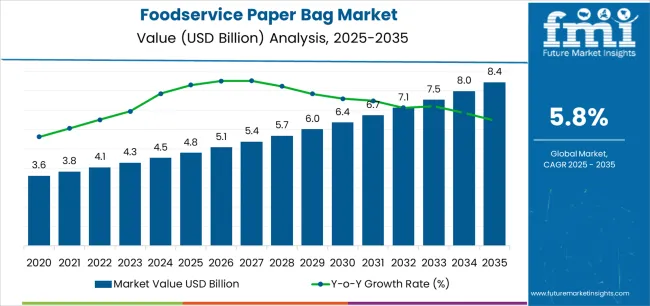
| Period | Primary Revenue Buckets | Share | Notes |
|---|---|---|---|
| Today | Flat bottom bags (standard) | 42% | Quick-service restaurants, takeout orders |
| SOS (self-opening sack) bags | 28% | Grocery items, bakery products | |
| Handled paper bags | 18% | Retail foodservice, premium packaging | |
| Specialty bags (grease-resistant) | 12% | Fast food, fried items packaging | |
| Future (3-5 yrs) | Premium grease-resistant bags | 32-38% | Food delivery growth, quality preservation |
| Custom-branded flat bags | 25-30% | Chain restaurants, brand visibility | |
| Handled premium bags | 15 to 20% | Upscale dining, takeout optimization | |
| Compostable certified bags | 10-15% | Environmental regulations, eco-conscious consumers | |
| Multi-layer barrier bags | 8-12% | Temperature retention, food safety |
The market demonstrates strong fundamentals with flat bottom paper bag systems capturing a dominant share through advanced structural capabilities and food packaging optimization. Quick-service restaurant applications drive primary demand, supported by increasing food delivery and premium packaging equipment adoption requirements.
Geographic expansion remains concentrated in developed markets with established foodservice cultures, while emerging economies show accelerating adoption rates driven by restaurant proliferation and rising quality standards.
At-a-Glance Metrics
| Metric | Value |
|---|---|
| Market Value (2025) | USD 4.8 billion |
| Market Forecast (2035) | USD 8.4 billion |
| Growth Rate | 5.8% CAGR |
| Leading Technology | Flat Bottom Paper Bags |
| Primary Application | Quick-Service Restaurant Segment |
Primary Classification: The market segments by bag type into flat bottom bags, SOS bags, handled bags, and specialty bags, representing the evolution from basic packaging materials to sophisticated delivery solutions for comprehensive food protection optimization.
Secondary Classification: Capacity segmentation divides the market into small bags (up to 5 lbs), medium bags (5-15 lbs), large bags (15-30 lbs), and extra-large bags (above 30 lbs), reflecting distinct requirements for food quantity, order size, and carrying capacity standards.
Tertiary Classification: Application segmentation covers quick-service restaurants, full-service restaurants, bakeries & cafes, food delivery services, and catering operations, while material composition spans virgin kraft paper, recycled kraft paper, and specialty coated paper categories.
Regional Classification: Geographic distribution covers North America, Latin America, Western Europe, Eastern Europe, East Asia, South Asia Pacific, and Middle East & Africa, with developed markets leading adoption while emerging economies show accelerating growth patterns driven by foodservice expansion programs.
The segmentation structure reveals technology progression from standard packaging materials toward sophisticated delivery systems with enhanced strength and grease resistance capabilities, while application diversity spans from quick-service operations to full-service restaurant establishments requiring precise packaging solutions.
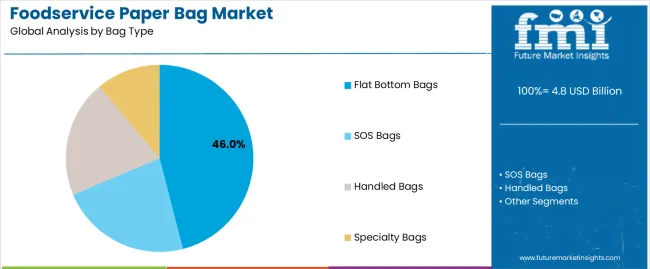
Market Position: Flat Bottom Bag systems command the leading position in the foodservice paper bag market with 46% market share through advanced structural features, including superior stability, load-bearing capacity, and food packaging optimization that enable food establishments to achieve optimal product presentation across diverse service and delivery environments.
Value Drivers: The segment benefits from restaurant preference for reliable packaging systems that provide consistent structural performance, enhanced food protection, and quality optimization without compromising bag integrity or affecting food presentation characteristics. Advanced paper engineering enables standing stability, visual appeal, and integration with existing packaging equipment, where structural performance and presentation consistency represent critical operational requirements.
Competitive Advantages: Flat Bottom Bag systems differentiate through proven structural reliability, consistent load-bearing characteristics, and integration with automated filling systems that enhance operational efficiency while maintaining optimal food safety standards suitable for diverse quick-service and commercial applications.
Key market characteristics:
SOS Bag systems maintain a 29% market position in the foodservice paper bag market due to their self-opening convenience and multi-purpose advantages. These systems appeal to establishments requiring efficient filling operations with competitive pricing for diverse food packaging applications. Market growth is driven by operator preference, emphasizing operational efficiency and versatile packaging through optimized bag design.
Handled Bag systems capture 16% market share through premium service requirements in upscale restaurants, specialty food retailers, and branded delivery operations. These establishments demand convenient carrying systems capable of handling diverse food items while providing exceptional customer experience and brand presentation.

Market Context: Medium capacity bags (5-15 lbs) demonstrate 35% market share in the foodservice paper bag market due to widespread adoption of family-sized orders and increasing focus on multi-item packaging, order consolidation, and delivery optimization that maximizes carrying efficiency while maintaining structural standards.
Appeal Factors: Medium bag operators prioritize carrying capacity, structural integrity, and integration with diverse food types that enables optimized packaging operations across multiple order sizes. The segment benefits from substantial food delivery investment and online ordering programs that emphasize the acquisition of medium bags for order optimization and customer convenience applications.
Growth Drivers: Food delivery expansion programs incorporate medium bags as standard packaging for family orders, while restaurant growth increases demand for versatile capacity capabilities that comply with safety standards and minimize packaging complexity.
Market Challenges: Varying food quantities and order composition may limit bag standardization across different restaurants or delivery scenarios.
Application dynamics include:
Small capacity bag applications capture market share through individual serving requirements in fast food chains, snack packaging, and single-item orders. These applications demand compact packaging systems capable of operating with quick-service equipment while providing effective food protection and operational simplicity capabilities.
Large capacity bag applications account for market share, including catering operations, bulk food orders, and high-volume packaging requiring substantial carrying capabilities for operational optimization and delivery efficiency.
Market Position: Quick-Service Restaurant applications command significant market position with 6.9% CAGR through growing fast food consumption trends and drive-through service adoption for rapid meal delivery.
Value Drivers: This application segment provides the ideal combination of speed and convenience, meeting requirements for fast service, brand presentation, and operational efficiency without reliance on dine-in service.
Growth Characteristics: The segment benefits from broad applicability across restaurant chains, automated packaging adoption, and established delivery programs that support widespread bag usage and operational convenience.
Market Context: Food Delivery Services dominate the market with 7.4% CAGR, reflecting the primary demand source for foodservice paper bags in delivery operations and online ordering platforms.
Business Model Advantages: Delivery services provide direct market demand for durable packaging materials, driving quality standards and delivery innovation while maintaining food safety and customer satisfaction requirements.
Operational Benefits: Delivery applications include order protection, quality assurance, and customer experience enhancement that drive consistent demand for paper bags while providing access to latest packaging technologies.
| Category | Factor | Impact | Why It Matters |
|---|---|---|---|
| Driver | Food delivery boom & online ordering platforms (third-party delivery apps, ghost kitchens) | ★★★★★ | Exponential growth in food delivery creates massive demand for takeout packaging; convenience-driven consumer behavior drives market expansion. |
| Driver | Quick-service restaurant expansion & fast-casual growth | ★★★★★ | Rapid proliferation of QSR chains globally; standardized packaging requirements across multiple locations drive bulk procurement and consistent demand. |
| Driver | Plastic bag bans & single-use plastic regulations (government mandates) | ★★★★★ | Regulatory pressure eliminating plastic alternatives; paper bags become default option for compliance with environmental legislation. |
| Restraint | Competition from reusable containers & alternative packaging formats | ★★★☆☆ | Growing adoption of returnable container programs in select markets; circular economy models create substitution pressure for disposable bags. |
| Restraint | Raw material cost volatility & kraft paper price fluctuations | ★★★★☆ | Pulp and paper price variations impact profit margins; commodity nature of basic bags constrains pricing power during cost increases. |
| Trend | Custom branding & printed bags for marketing (logo visibility, social media appeal) | ★★★★★ | Restaurants leveraging packaging as advertising medium; Instagram-worthy designs drive premium bag adoption for brand differentiation. |
| Trend | Grease-resistant & moisture-barrier innovations (advanced coating technology) | ★★★★☆ | Technical improvements enhancing food quality preservation; water-based barriers replacing traditional wax coatings for better performance. |
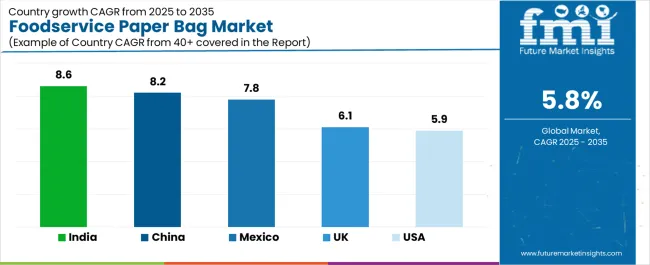
The foodservice paper bag market demonstrates varied regional dynamics with Growth Leaders including China (8.2% growth rate) and India (8.6% growth rate) driving expansion through restaurant proliferation and food delivery growth initiatives.
Steady Performers encompass United States (5.9% growth rate), United Kingdom (6.1% growth rate), and developed regions, benefiting from established foodservice cultures and delivery platform adoption. Emerging Markets feature Mexico (7.8% growth rate) and developing regions, where quick-service restaurant expansion and packaging modernization support consistent growth patterns.
Regional synthesis reveals North American markets leading value generation through premium product adoption and branded packaging culture, while Asian markets demonstrate highest volume growth supported by restaurant proliferation and rising food delivery trends. European markets show moderate growth driven by regulatory packaging requirements and quality enhancement integration.
| Region/Country | 2025 to 2035 Growth | How to win | What to watch out |
|---|---|---|---|
| China | 8.2% | Food delivery scale; cost-effective solutions | Quality inconsistency; local competition |
| India | 8.65 | QSR expansion; affordable premium bags | Infrastructure gaps; distribution challenges |
| United States | 5.9% | Custom branding; grease-resistant innovation | Regulatory complexity; margin pressure |
| United Kingdom | 6.1% | Compliance solutions; premium positioning | Brexit impacts; cost sensitivities |
| Mexico | 7.8% | Fast food growth; regional partnerships | Economic volatility; logistics constraints |
China establishes fastest market growth through massive food delivery infrastructure and comprehensive restaurant development, integrating advanced foodservice paper bags as standard components in delivery operations and quick-service installations. The country's 8.2% growth rate reflects explosive online ordering adoption and domestic foodservice industry expansion that mandates the use of quality packaging systems in commercial and delivery facilities.
Growth concentrates in major urban centers, including Shanghai, Beijing, and Guangzhou, where food delivery platforms showcase integrated packaging systems that appeal to restaurants seeking advanced food protection capabilities and delivery optimization applications.
Chinese manufacturers are developing domestically-produced bag solutions that combine local production advantages with functional operational features, including enhanced grease resistance and structural integrity capabilities. Distribution channels through restaurant supply chains and delivery platform partnerships expand market access, while food delivery culture supports adoption across diverse commercial and quick-service segments.
Strategic Market Indicators:
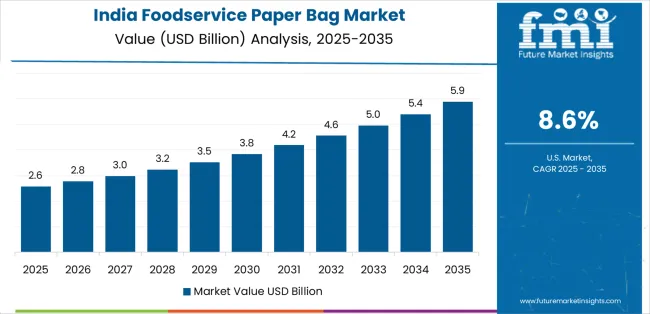
In Mumbai, Delhi, and Bangalore, restaurants and food delivery services are implementing foodservice paper bags as standard packaging for food safety and customer satisfaction applications, driven by increasing restaurant investment and delivery platform programs that emphasize the importance of packaging quality. The market holds an 8.6% growth rate, supported by quick-service restaurant expansion and urbanization programs that promote quality bag systems for commercial and delivery applications. Indian operators are adopting bag solutions that provide consistent structural performance and food protection features, particularly appealing in urban regions where food delivery and packaging quality represent critical consumer expectations.
Market expansion benefits from growing middle-class consumption patterns and restaurant proliferation that enable widespread adoption of quality packaging systems for foodservice and delivery applications. Technology adoption follows patterns established in retail packaging, where functionality and value drive procurement decisions and operational deployment.
Market Intelligence Brief:
United States establishes market leadership through comprehensive fast food programs and advanced foodservice culture development, integrating foodservice paper bags across restaurant and delivery applications. The country's 5.9% growth rate reflects established quick-service consumption patterns and mature packaging technology adoption that supports widespread use of premium bag systems in restaurants and delivery facilities.
Growth concentrates in major metropolitan areas, including New York, Los Angeles, and Chicago, where food delivery culture showcases mature bag deployment that appeals to restaurant operators seeking proven food protection capabilities and brand presentation applications.
American foodservice establishments leverage established distribution networks and comprehensive product availability, including custom-printed bags and grease-resistant options that create brand differentiation and operational advantages. The market benefits from mature delivery infrastructure and consumer willingness to invest in quality packaging materials that enhance food experience and presentation optimization.
Market Intelligence Brief:
United Kingdom's advanced environmental regulation market demonstrates sophisticated foodservice paper bag deployment with documented compliance effectiveness in quick-service applications and delivery facilities through integration with existing packaging systems and regulatory infrastructure. The country leverages plastic ban legislation and packaging standards to maintain a 6.1% growth rate. Urban centers, including London, Manchester, and Birmingham, showcase premium installations where paper bags integrate with comprehensive delivery platforms and compliance systems to optimize food protection operations and regulatory effectiveness.
UK operators prioritize packaging compliance and environmental credentials in bag procurement, creating demand for certified products with advanced features, including compostable certifications and recycled content. The market benefits from established environmental consciousness and a willingness to invest in premium packaging materials that provide superior compliance benefits and adherence to regulatory standards.
Market Intelligence Brief:
Mexico's market expansion benefits from diverse foodservice demand, including QSR expansion in Mexico City and Monterrey, restaurant establishment growth, and rising delivery consumption that increasingly incorporate paper bag solutions for food packaging applications. The country maintains a 7.8% growth rate, driven by urbanization and increasing recognition of paper bag benefits, including improved food protection and enhanced brand presentation.
Market dynamics focus on affordable quality bag solutions that balance packaging performance with cost considerations important to Mexican restaurant operators. Growing quick-service restaurant proliferation creates continued demand for modern packaging systems in new establishment infrastructure and foodservice modernization projects.
Strategic Market Considerations:
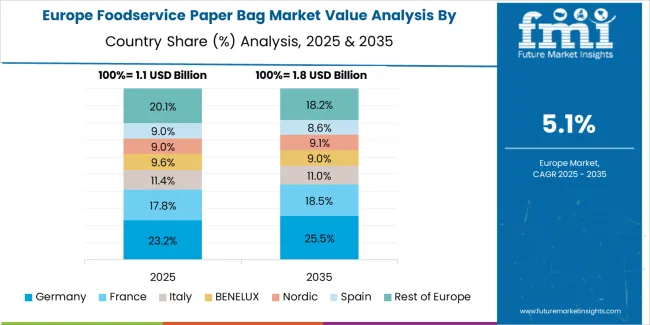
The European foodservice paper bag market is projected to grow from USD 1.6 billion in 2025 to USD 2.7 billion by 2035, registering a CAGR of 5.4% over the forecast period. Germany is expected to maintain its leadership position with a 28.7% market share in 2025, supported by its strong environmental regulations and quick-service restaurant density.
United Kingdom follows with a 26.3% share in 2025, driven by plastic bag bans and food delivery platform expansion. France holds a 21.4% share through traditional foodservice culture and takeout applications. Italy commands a 12.8% share, while Spain accounts for 10.8% in 2025.
The rest of Europe region is anticipated to gain momentum, expanding its collective share from 6.4% to 7.1% by 2035, attributed to increasing food delivery adoption in Nordic countries and emerging quick-service establishments implementing quality packaging programs.
| Stakeholder | What they actually control | Typical strengths | Typical blind spots |
|---|---|---|---|
| Global manufacturers | Production capacity, supply chain, distribution networks | Scale efficiency, consistent quality, broad reach | Innovation speed; local customization |
| Specialty converters | Custom printing; grease-resistant technology; premium designs | Quality leadership; restaurant partnerships; differentiation | Mass market penetration; price competition |
| Regional producers | Local manufacturing, distribution channels, competitive pricing | Market proximity; cultural understanding; cost advantage | Technology gaps; international expansion |
| Private label suppliers | Retailer partnerships, value positioning, volume production | Price competitiveness; retail access; volume scale | Brand loyalty; premium segment access |
| Packaging innovators | Coating technology, barrier solutions, material science | Technical expertise; patent portfolio; performance | Market scalability; distribution challenges |
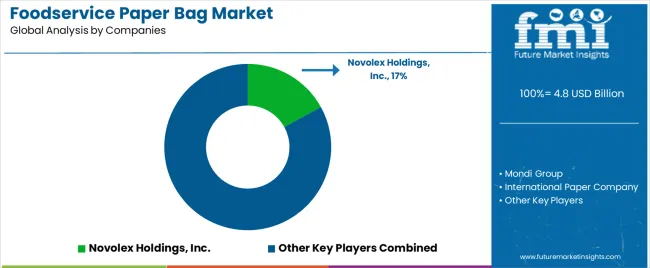
| Item | Value |
|---|---|
| Quantitative Units | USD 4.8 billion |
| Bag Type | Flat Bottom Bags, SOS Bags, Handled Bags, Specialty Bags |
| Capacity | Small (up to 5 lbs), Medium (5-15 lbs), Large (15-30 lbs), Extra-Large (above 30 lbs) |
| Material Composition | Virgin Kraft Paper, Recycled Kraft Paper, Specialty Coated Paper |
| Application | Quick-Service Restaurants, Full-Service Restaurants, Bakeries & Cafes, Food Delivery Services, Catering |
| Regions Covered | North America, Latin America, Western Europe, Eastern Europe, East Asia, South Asia Pacific, Middle East & Africa |
| Countries Covered | United States, China, Germany, India, United Kingdom, Mexico, Canada, Japan, France, Brazil, and 30+ additional countries |
| Key Companies Profiled | Novolex Holdings Inc., Mondi Group, International Paper Company, WestRock Company, Smurfit Kappa Group, Genpak LLC, KapStone Paper and Packaging |
| Additional Attributes | Dollar sales by bag type and capacity categories, regional adoption trends across North America, East Asia, and Western Europe, competitive landscape with packaging manufacturers and foodservice suppliers, consumer preferences for food protection and brand presentation, integration with delivery platforms and restaurant systems, innovations in grease resistance technology and structural enhancement, and development of compostable bag solutions with enhanced performance and food protection capabilities. |
The global foodservice paper bag market is estimated to be valued at USD 4.8 billion in 2025.
The market size for the foodservice paper bag market is projected to reach USD 8.4 billion by 2035.
The foodservice paper bag market is expected to grow at a 5.8% CAGR between 2025 and 2035.
The key product types in foodservice paper bag market are flat bottom bags, sos bags, handled bags and specialty bags.
In terms of capacity, small (up to 5 lbs) segment to command 0.0% share in the foodservice paper bag market in 2025.






Full Research Suite comprises of:
Market outlook & trends analysis
Interviews & case studies
Strategic recommendations
Vendor profiles & capabilities analysis
5-year forecasts
8 regions and 60+ country-level data splits
Market segment data splits
12 months of continuous data updates
DELIVERED AS:
PDF EXCEL ONLINE
Competitive Overview of Foodservice Paper Bag Companies
Foodservice Equipment Market Analysis - Size, Share, and Forecast Outlook 2025 to 2035
Europe Foodservice Disposables Market Insights – Growth & Trends 2024-2034
Foodservice Disposable Market Growth & Trends Forecast 2024-2034
Compostable Foodservice Packaging Market Size and Share Forecast Outlook 2025 to 2035
Market Share Insights of Compostable Foodservice Packaging Providers
Paper Edge Protector Market Size and Share Forecast Outlook 2025 to 2035
Paper Cup Lids Market Size and Share Forecast Outlook 2025 to 2035
Paper Pallet Market Size and Share Forecast Outlook 2025 to 2035
Paper and Paperboard Packaging Market Forecast and Outlook 2025 to 2035
Paper Wrap Market Size and Share Forecast Outlook 2025 to 2035
Paper Cups Market Size and Share Forecast Outlook 2025 to 2035
Paper Core Market Size and Share Forecast Outlook 2025 to 2035
Paper Processing Resins Market Size and Share Forecast Outlook 2025 to 2035
Paper Tester Market Size and Share Forecast Outlook 2025 to 2035
Paper Napkin Converting Lines Market Size and Share Forecast Outlook 2025 to 2035
Paper Packaging Tapes Market Size and Share Forecast Outlook 2025 to 2035
Paper Napkins Converting Machines Market Size and Share Forecast Outlook 2025 to 2035
Paper Coating Binders Market Size and Share Forecast Outlook 2025 to 2035
Paper Core Cutting Machine Market Size and Share Forecast Outlook 2025 to 2035

Thank you!
You will receive an email from our Business Development Manager. Please be sure to check your SPAM/JUNK folder too.
Chat With
MaRIA